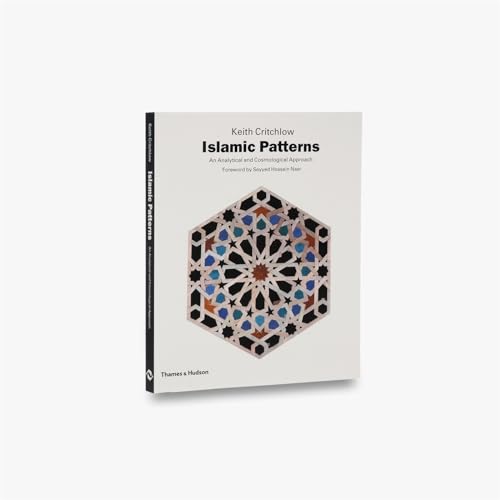
Sinossi
A practical source of inspiration for artists and designers and an invaluable study for anyone with an interest in sacred art
Le informazioni nella sezione "Riassunto" possono far riferimento a edizioni diverse di questo titolo.
Informazioni sull?autore
Dr. Keith Critchlow is the co-founder of the journal Temenos, as well as the author of numerous books on sacred geometry. He is Professor Emeritus at The Prince’s School of Traditional Arts in London, and a former professor of Islamic Art at the Royal College of Art.
Dalla quarta di copertina
Islamic art has long been misunderstood in the West as no more than decoration. This study explains how the geometrical patterns of Islamic art reveal intrinsic cosmological laws. The primary function of the patterns is to lead the mind from the literal world towards the underlying reality.
Le informazioni nella sezione "Su questo libro" possono far riferimento a edizioni diverse di questo titolo.
Altre edizioni note dello stesso titolo
Risultati della ricerca per Islamic Patterns: An Analytical and Cosmological Approach
Islamic Patterns: An Analytical and Cosmological Approach
Da: WeBuyBooks, Rossendale, LANCS, Regno Unito
Condizione: Good. Most items will be dispatched the same or the next working day. A copy that has been read but remains in clean condition. All of the pages are intact and the cover is intact and the spine may show signs of wear. The book may have minor markings which are not specifically mentioned. Codice articolo wbs1342103016
Compra usato
Quantità: 1 disponibili
Islamic Patterns
Da: Timshala Books, Olathe, KS, U.S.A.
Soft cover. Condizione: New. New, unread, with cover and pages tanned from age. Codice articolo 100001101
Compra nuovo
Quantità: 1 disponibili
Islamic Patterns: An Analytical and Cosmological Approach
Da: WorldofBooks, Goring-By-Sea, WS, Regno Unito
Paperback. Condizione: Good. The book has been read but remains in clean condition. All pages are intact and the cover is intact. Some minor wear to the spine. Codice articolo GOR002468672
Compra usato
Quantità: 1 disponibili
Critchlow ISLAMIC PATTERNS: AN ANALYTICAL AND COSMOLOGICAL APPROACH
Da: Genesis Books, Fonte Nuova, RM, Italia
Condizione: Good. Il cofanetto (se previsto) può presentare modeste tracce d'uso, piccole lesioni, fioriture e macchie non invasive.Sovraccoperta con modeste tracce d'uso. Può presentare piccole mancanze, leggere bruniture, rade fioriture o macchiette.Copertina con modeste tracce d'uso. Può presentare minime mancanze, qualche rada fioritura o macchietta, leggere bruniture o piccole pieghe.Dorso in buone condizioni. Può presentare un fisiologico stress da lettura, piccole mancanze e segni di cedevolezza in prossimità delle cerniere.Tagli moderatamente bruniti; possono presentare fioriture rade.L'interno può presentare modeste tracce d'uso, segni a matita, timbro o firma di appartenenza. Le pagine possono presentare minime gualciture, fioriture non invasive e leggere bruniture.Per Maggiori informazioni o foto non esitate a contattarci. . Buono (Good). Book. Codice articolo EV04061
Compra usato
Quantità: 1 disponibili
Islamic Patterns: An Analytical and Cosmological Approach
Da: Anybook.com, Lincoln, Regno Unito
Condizione: Good. This is an ex-library book and may have the usual library/used-book markings inside.This book has soft covers. In good all round condition. Please note the Image in this listing is a stock photo and may not match the covers of the actual item,650grams, ISBN:0500270716. Codice articolo 3962999
Compra usato
Quantità: 1 disponibili
Islamic Patterns: An Analytical and Cosmological Approach
Da: Toscana Books, AUSTIN, TX, U.S.A.
Paperback. Condizione: new. Excellent Condition.Excels in customer satisfaction, prompt replies, and quality checks. Codice articolo Scanned0500270716
Compra nuovo
Quantità: 1 disponibili
Islamic Patterns: An Analytical and Cosmological Approach
Da: WorldofBooks, Goring-By-Sea, WS, Regno Unito
Paperback. Condizione: Very Good. For centuries the nature and meaning of Islamic art has been misunderstood in the West, being regarded as no more than decoration. But in fact the abstract art of Islam represents the sophisticated development of a supra-naturalistic tradition, since the portrayal of human and animal forms has always been discouraged by the Prophet Muhammad, so as to avoid idolatry. Hence, among the world's great artistic traditions, Islamic art has maintained its singular integrity and inner content with the least diversion from its aim: the affirmation of unity as expressed in diversity. The Pythagorean/Platonic doctrines are easily recognizable in the body of Islamic geometric art, as the wisdom of this practice was exalted by Socrates, in Plato's Republic dialogue (527), when he specifically gave the reason for practising geometry. Its practice rekindled the inner organ (or eye of wisdom) by which alone we can see the truth. The geometrical patterns of Islamic art reveal to the eye of the sensitive onlooker the intrinsic cosmological laws affecting all Creation. The primary function of these patterns is to lead the mind from the literal and mundane world towards the underlying permanent reality. The numerous sequential drawings show how the art of Islam is inseparable from the science of mathematics. Thus, we can see clearly how an Earth-centred - 'common-sense' - view of the cosmos gives renewed signficance to the number patterns produced by the orbits of the planets, correlating the cosmos as experienced by man with the patterns created in Islamic art, and thereby throwing new light on the perennial symbolic significance of number. The mathematical tessellations inherent in space-filling patterns are revealed as an essential practical and philosophical basis for the creation of each completed work of art - whether a tile, a carpet, a wall or an entire building - and thus affirm the underlying essential unity of all things. The book has been read, but is in excellent condition. Pages are intact and not marred by notes or highlighting. The spine remains undamaged. Codice articolo GOR001331130
Compra usato
Quantità: 2 disponibili

